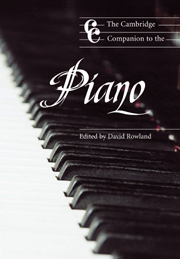Book contents
4 - Pianists on record in the early twentieth century
from Part one - Pianos and pianists
Published online by Cambridge University Press: 28 September 2011
Summary
The experience of recording
The modern recording studio is a very different place from the studios of the early twentieth century, and the process of making records has changed very greatly. Until the introduction of tape recording around 1950, pianists, like other musicians, recorded onto a wax disc one side at a time. The maximum length was about four and a half minutes by the 1930s, shorter in the early days. Recordings could not be edited, and they could not even be played back at the time without destroying the wax master. Before the advent of electrical recording in the mid 1920s, the frequency range was very limited in both bass and treble, making a concert grand piano sound more like a small upright.
The first important pianists to make records were Alfred Grünfeld in Vienna in 1899, and Raoul Pugno in Paris in 1903. But for several years into the twentieth century the principal work of the studios was vocal recording. Because the acoustic recording horns were very directional, the piano used for accompaniment was raised up to the same level as the singer's head. In 1902, Caruso's accompanist Salvatore Cottone played on an upright piano set up on a platform of packing cases. Pugno's recordings were made under similar conditions. Even when solo piano recording became established, and grand pianos were routinely used in the studio, the pre-electric recording still had limitations.
- Type
- Chapter
- Information
- The Cambridge Companion to the Piano , pp. 75 - 95Publisher: Cambridge University PressPrint publication year: 1998
- 2
- Cited by



